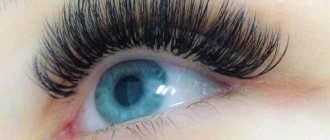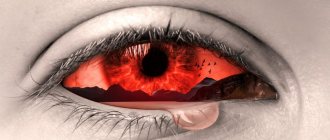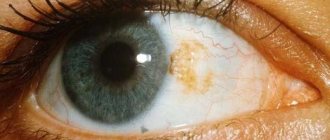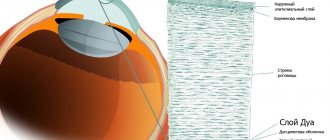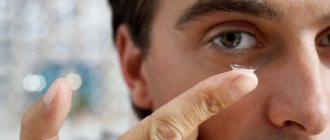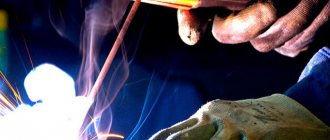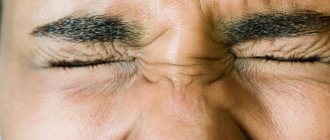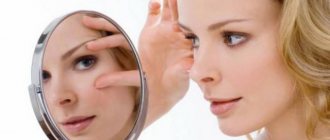Home / Bulbs / Ultraviolet
Back
Reading time: 4 min
0
472
Quartz and ultraviolet lamps are actively used to disinfect premises. They emit strong radiation and can cause serious eye burns if used incorrectly. This can happen unnoticed, but the consequences will appear over time. Let's look at the main symptoms of damage and treatment methods.
- Is it possible to look at a quartz lamp? The effect of ultraviolet radiation on the eyes
- Symptoms
- Possible consequences
The effect of a quartz lamp on the retina of the eye
Quartz treatment of premises helps fight microbes, treat skin diseases, arthritis and other diseases. The device has many positive qualities, but ultraviolet radiation negatively affects vision, which leads to its deterioration.
To prevent this from happening, you need to use the lamp correctly and look at it only with special glasses.
There are three types of quartz lamps:
- long-wavelength ones, affecting photochemical processes, provoke the appearance of pigment spots on the skin, but not its redness;
- medium wavelengths help produce vitamin D, have a positive effect on the body’s respiratory and defense systems, and also increase the level of red blood cells in the blood;
- short-wavelengths destroy bacteria and are used to disinfect premises, but cause redness of the skin.
Harm and benefit for humans?
Quartz lamps, depending on their purpose and wavelength, can be divided into 3 types:
- Long-wave – provokes the production of melanin, does not cause external manifestations on the skin.
- Medium wave - causes the growth of age spots, however, has a beneficial effect on the body, provoking the production of vitamin D, which improves breathing and increases the number of red blood cells.
- Short-wave – destroys pathogenic bacteria and viruses, which is why it is used to disinfect air in public places. Short-wavelength light can seriously damage the eyeball and cause skin burns.
IMPORTANT! Before using a quartz lamp, you should carefully read the operating instructions for the device.
Why is it dangerous for the eyes?
You can get a burn to the conjunctiva (the mucous membrane of the eyeball) due to:
- Staying indoors for a long time with the lamp on.
- Reckless increase in lamp power.
- The device is too close to the face.
- High sensitivity of the body to this kind of influence.
REFERENCE! A quartz burn is somewhat different in appearance from a chemical or thermal burn, since the entire eye is damaged, including the skin of the eyelid and the protein membrane.
Skin hazard
Skin burns can occur during unprofessional treatment and prophylactic procedures. Most often, trauma to the skin occurs during:
- Treatment of inflammatory lung diseases.
- Treating skin ulcers or severe frostbite.
- In case of improper antibacterial treatment of premises.
Externally, a burn from a quartz lamp is expressed by redness, swelling at the site of the lesion and pain upon contact. Small, watery blisters may form.
On a note! The skin begins to itch very much, however, you should not scratch it - this can only worsen the situation.
Signs of different degrees of eye burns
The degree of damage depends on prolonged exposure to a quartz device, since its radiation negatively affects vision. A burn from a quartz lamp is possible due to increased ultraviolet radiation, insufficient distance from the emitter and eye sensitivity.
There are three degrees of damage, and each has its own special symptoms.
Minor burn
Signs of the first degree appear if you look at a quartz lamp for just a few seconds. Symptoms do not appear immediately, but after a few hours:
- tearfulness;
- fear of light;
- hyperemia;
- swelling of the eyelids.
Medium burn
Signs of the second degree appear in the form of redness of the conjunctiva, damage to the cornea of the eyes, fear of light, which makes them difficult to open. When erosion appears on the cornea, it begins to become cloudy, which leads to deterioration of vision.
Symptoms of a moderate burn appear almost immediately:
- swelling of the eyelids;
- pain;
- blepharospasm;
- signs of hyperemia.
Severe burn
Signs of the third degree occur if you look at a quartz lamp for a long time. This causes blisters to appear on the eyelids, pain, it becomes very difficult to open the eyes, and tearing. The cornea of the eye becomes like frosted glass, a crust forms on the eyelids, which dies over time. If the eyes are open while the emitter is operating, deep damage to the eyeball occurs. In severe cases, symptoms appear immediately.
Similar symptoms occur in welders without protective equipment. When welding, a spectrum containing ultraviolet rays is formed, which causes burns.
Symptoms
Burns caused by a quartz lamp are divided into three types - mild, moderate and severe. The severity of symptoms will vary in each case.
- Lungs. If a person was in the room with a working lamp for a short time, did not look at it directly or took a fleeting glance, the damage will most likely be minor. The skin of the eyelids may be damaged, but the tissues of the eye will not be affected. It is typical that symptoms in this case will not appear immediately. For at least an hour after exposure to the rays, a person will not feel any discomfort. Sometimes signs of photoophthalmia appear only the next day: redness of the eyes and eyelids, pain, lacrimation, photophobia, difficulty blinking.
- Average. If the cornea and conjunctiva have been exposed to harmful radiation, the manifestations of the disease will be more intense and will occur almost immediately . Pain, inflammation and tissue swelling are stronger in this case. It is difficult for a person to keep his eyes open because the eyelids reflexively close.
- Strong. If the victim was near the quartz lamp long enough and their eyes received a significant dose of ultraviolet radiation, it would cause severe burns. In this case, the eyelids become covered with crusts and blisters and swell so much that the patient cannot open his eyes. The pain can be very severe.
In addition, there is a special group of extremely severe ultraviolet burns, in which most of the eye tissue is destroyed. But getting such severe damage from exposure to a quartz lamp is unlikely.
First aid
If your eyes are burned by an ultraviolet lamp, you should consult a doctor. Under no circumstances should you self-medicate. If the form is mild, the victim should be taken to the hospital wearing sunglasses.
In severe cases, you need to call an ambulance, and before it arrives, provide the victim with first aid:
- turn off the quartz lamp;
- transfer the victim to another room, creating twilight in it;
- if the damage is first degree, then make simple lotions from infusions of chamomile and calendula;
- if the damage is second degree, the eyes should be instilled with painkillers;
- every 30 minutes they should be dripped with Levomycetin (0.25%) and Furacilin (dissolve two tablets in boiled water, and strain the resulting solution through gauze);
- in the third degree, first aid cannot be provided except for turning off the emitter and creating twilight in the room. Then you need to call an ambulance.
If the patient has received the first degree of damage, then he is sent home with recommendations for further treatment, and the patient with the third degree remains in the hospital under the supervision of medical personnel.
Why is ozone harmful?
Despite all the benefits of quartzization, under certain circumstances this device can be harmful to health, namely:
- If the device is used incorrectly;
- If there are health contraindications.
- As a result of using the wrong type of device.
There are two types of devices for quartzing a room - open and closed modifications.
The former are not suitable for domestic use, as they have too aggressive an effect on the air. That is why when using devices of this type, the room must be completely free of people, animals and even indoor plants. The room can be used again only an hour after it has been ventilated.
Closed lamps are more versatile; however, when using, you should carefully inspect the so-called tube for microcracks. Such damage to the device most often causes burns.
Treatment methods
If you are burned by ultraviolet light, you should consult an ophthalmologist. After a medical examination, victims of mild and sometimes moderate type continue to be treated at home.
Various drugs with analgesic properties are used as therapy:
- Tetracycline ointment is used for infectious and inflammatory processes.
- To heal the cornea of the eye, use Korneregel in the form of a gel.
- Novocaine is used for pain relief.
During this period, the patient must follow the doctor’s recommendations, stay in twilight and adhere to bed rest, but should not watch TV or strain his eyesight. Hospital stay is necessary for complex burns.
Despite the fact that you cannot self-medicate, Vaseline or peach oil, as well as lotions made from chamomile or calendula decoction, will help reduce pain. Treatment for the first and second degrees will take 3–5 days. During this time, you cannot go outside and look at the light. For severe burns, treatment takes much longer and only under the supervision of a doctor.
Peculiarities
Quartz lamps are used in different conditions:
- in kindergartens;
- in sanatoriums;
- in hospitals and clinics;
- in some cases, such equipment is also used at home.
If you follow simple precautions, it is impossible to get an eye burn from a quartz lamp, but sometimes such injuries do occur . Depending on a number of factors, the burn can be of varying degrees.
This is influenced by the power and number of lamps, the time a person spends in the room with the quartz lamp turned on, as well as the duration of direct exposure of the quartz lamp to the organs of vision.
As a result of such damage, both the outer layer of the mucous membrane and the deeper layers of the eye can be damaged. In the second case, injuries to the retina and cornea are possible.
Care and possible consequences
The patient should not watch TV, sit at the computer or read books, because this greatly strains the eyesight. To restore the mucous membrane of the eye, you need to create twilight in the room and exclude exposure to bright sunlight.
Ultraviolet burns are very harmful, as it can lead to the following consequences:
- various eye diseases;
- eyelid deformities;
- in the case of a third degree burn, the inner side of the eyelid fuses with the conjunctival side;
- complete or partial loss of vision.
Such problems appear due to strong radiation if first aid was carried out incorrectly and the doctor’s recommendations were ignored.
To prevent complications from developing, you should not put pressure on your eyes, rinse them with water, rub them, or apply a bandage. You should also not self-medicate or puncture blisters. You can apply lotions only with cotton wool.
Possible complications
One of the likely complications of severe burns is the fusion of the conjunctiva with the inside of the eyelid. The risk of improper healing increases with friction and pressure on the affected organs, so it is important not to rub the eyes with your hands or apply pressure bandages to the patient.
As a result of improper healing, scarring and deformation of the eyelids may occur. In addition, the consequences of a burn can be serious diseases such as glaucoma, cataracts, retinal detachment, endophthalmitis, and iridocyclitis.
Quite common complications are dry eye syndrome and conjunctivitis. The most severe radiation damage to the eyes, especially if the patient was not provided with timely assistance, can lead to necrosis of the cornea and complete loss of vision.
Eye burns from a quartz lamp are very unpleasant and dangerous, but they can be avoided if you follow basic safety measures when operating these devices. Do not enter the room where ultraviolet treatment is being carried out. During procedures in which the patient is exposed to quartz radiation, his eyes must be protected with special glasses.
Precautionary measures
Before buying an ultraviolet emitter, you need to find out reviews about it and get a doctor’s recommendation. Before connecting the device to the network, you must read the instructions, then leave it running for a while, while there should be no children in the room, and use sunglasses to protect your eyesight.
You can prevent eye burns if you follow precautions, select the power of the device for the area of the room, do not enter it during quartzing and be sure to ventilate it after. For home use, it is best to use closed type lamps, as they are less dangerous.
We recommend watching the video:
According to strict rules
As Anton Skopin, head of the laboratory of sterilization problems at the Research Institute of Disinfectology of Rospotrebnadzor, emphasized in an interview with Izvestia, the use of quartz lamps is possible only in accordance with methodological documents and guidelines for the use of ultraviolet radiation, which describe all the restrictions, requirements for premises and placement of these irradiators . Using these devices in the presence of people is strictly prohibited.
In particular, according to this manual, for premises with bactericidal installations, a commissioning certificate must be issued and a registration and control log must be kept, and personnel who have not undergone the necessary training in the prescribed manner should not be allowed to operate such equipment.
It is open-type lamps that pose such health risks, sanitary doctor and quality director Nikolai Dubinin noted in a conversation with Izvestia. He also recalled that a similar incident had previously occurred in Moscow. Then the first-grade teacher used an open-type irradiator to disinfect the air during recess and forgot to turn it off at the beginning of the lesson. As a result, several children sought medical help.
With tears in his eyes
Photo: TASS/PENG NIAN
School changes: how children will learn during COVID-19
Teachers in masks, empty corridors and a “morning filter” await students.
— When using this type of lamp, you need to remember safety. If the lamp is not turned off, then eye burns are guaranteed. To do this, it is enough just to be in the field of view of this lamp; it is not necessary that it hangs right in front of the class. You should choose the right equipment, for example, safe recirculators, where the human factor is excluded and there is no need for any inclusion in the log by the responsible person,” he added.
First of all, upon contact with ultraviolet radiation, damage occurs to the cornea of the eye, recalls ophthalmologist Vitaly Klyuganov. “This is accompanied by sharp pain, the eye turns red. An extremely painful and unpleasant situation, but this can all be restored with special drops. Of course, in principle, direct exposure to ultraviolet radiation on the eyes should not be allowed,” he concluded.
